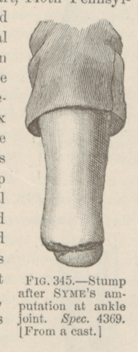Title: Covell, E. R.
Source text: The Medical and Surgical History of the War of the Rebellion. (1861-65.), Part 3, Volume 2 (Washington, DC: Government Printing Office, 1883), 597.
Civil War Washington ID: med.d2e22917
TEI/XML: med.d2e22917.xml
CASE 872.—Private E. R. Covell, Co. C, 52d New York, aged 38 years, was wounded in the left foot, at Spottsylvania, May 18, 1864, and admitted to the field hospital of the 1st division, Second Corps. Surgeon J. W. Wishart, 140th Pennsylvania, described the injury as a "shell wound of the tarsal and metatarsal bones," for which he performed "Syme's amputation at the ankle joint." Ten days after being wounded the patient entered Emory Hospital at Washington, and subsequently he was transferred to Central Park Hospital, New York City. Surgeon B. A. Clements, U. S. A., in charge of the latter, reported the following history of the case: "Considerable hæmorrhage took place at the time of the injury, and the man's general condition was not very good in consequence of his suffering from diarrhœa. Amputation at the ankle joint was performed under chloroform six hours after the reception of the injury, the ends of the tibia and fibula also being removed. Sutures, adhesive strips, and cold-water dressings were applied. The parts did not unite by first intention, though there was no sloughing nor necrosis. When the patient was admitted to Central Park Hospital, August 17th, the stump had healed with the exception of a small ulcer in the cicatrix near the external angle of the flaps, and his general condition was pretty good, though he still had diarrhœa. By October 2d the stump was entirely healed and the diarrhœa was much improved." The patient was discharged from service November 3, 1864, and pensioned, having been previously furnished with an artificial foot. A cast of the stump (Spec. 4369) was contributed to the Museum by Surgeon J. J. Milhan, U. S. A., and is represented in the adjoining wood-cut (FIG. 345). After leaving the service the stump was re-amputated at the lower third of the leg on May 5, 1869. In his subsequent applications for commutation the pensioner described the condition of the stump as "sound and healthy." His pension was paid September 4, 1881.¹
¹ SMITH (S.), Amputations at the Ankle Joint in Military Surgery, in U. S. San. Com. Memoirs, New York, 1871, Surgical Volume II, p. 136.
